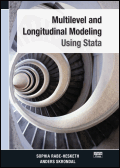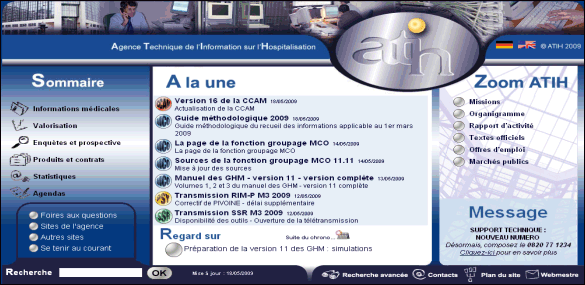LU POUR VOUS DE MAI 2009 : livres du mois - sites du mois - working papers
Tous les lu pour vous
LES LIVRES DU MOIS
Les établissements de santé : un panorama pour l'année 2006.
Ministère de la santé et des solidarités. Direction de la Recherche des Etudes de l'Evaluation et des Statistiques. (Drees). Paris.
Paris : La documentation française : 2009 : 93 p.
Cet ouvrage présente les principales données relatives au système hospitalier français : elles portent sur les équipements, personnels et financements qui concourent aux différentes prises en charge par les établissements, ainsi que sur leur activité et leur clientèle. Les fiches thématiques comportent chacune une sélection de tableaux, graphiques et cartes accompagnée d'un commentaire présentant les traits les plus caractéristiques des domaines abordés.
Le livre noir des hôpitaux.
Houdart P., Malye F., Vincent J.
Paris : Calmann-Levy : 2009 : 262 p.
Mortalité variant de 1 à 10 dans des établissements distants de seulement quelques kilomètres, bavures médicales, hôpitaux à l'activité confidentielle et médiocre soutenus à bout de bras par des élus locaux qui, eux, se font opérer dans les grands centres, explosion des honoraires médicaux, gâchis et scandales financiers...La liste des dérives du "meilleur système de santé du monde" est longue et édifiante. Pour tenter d'y remédier, un État irresponsable lance des réformes qui ignorent l'essentiel: les malades, les personnels soignants et la qualité des soins. Pour réaliser cette enquête, les auteurs ont mené des entretiens avec des centaines de spécialistes, médecins, infirmières, administratifs, patients heureux ou malheureux, décrypté des bases de données complexes révélant l'activité des établissements et épluché des milliers de rapports confidentiels.
L'évaluation des psychothérapies et de la psychanalyse : fondements et enjeux.
Fischman G.
Paris : Elsevier-Masson : 2009 : 286 p.
Depuis la parution du rapport Inserm sur l'évaluation des psychothérapies, la polémique initiale a laissé place à un débat de grand intérêt clinique et épistémologique dont ce livre se fait l'écho. L'objectif est d'enrichir ce débat en proposant au lecteur une analyse approfondie des logiques et des méthodologies à l'oeuvre dans l'évaluation des psychothérapies et de la psychanalyse. Les auteurs interrogent les postulats et les méthodes: comment la subjectivité pourra-t-elle être mesurée afin de déterminer quantitativement les effets d'une psychothérapie? Quelles sont les recherches réalisées en psychanalyse et l'évolution actuelle des investigations sur les psychothérapies? La recherche prônée par l'evidence based medicine peut-elle établir la norme d'une psychothérapie fondée sur la science? Le livre s'intéresse également aux enjeux politiques et culturels qui sous-tendent ce débat : les résultats issus du calcul de l'efficacité deviendront-ils le seul standard de v face à la singularité des individus? L'idéal de l'expertise biomédicale servira-t-il une politique visant à réduire la complexité de l'humain à des considérations gestionnaire? Georges Fischman a ainsi réuni dans ce livre polyphonique cliniciens et des chercheurs qui dépassent leurs divergences théoriques. Ils proposent de nouveaux axes de réflexion sur un sujet dont les enjeux sont fondamentaux pour notre société.
Multilevel and longitudinal modeling using Stata.
Modélisation longitudinale et multiniveau avec Stata.
Hesketh S., Skondal A.
Texas : Stata Press : 2008 : 562 p.
Multilevel and Longitudinal Modeling Using Stata, by Sophia Rabe-Hesketh and Anders Skrondal, looks specifically at Stata's treatment of generalized linear mixed models, also known as multilevel or hierarchical models. These models are "mixed" because they allow fixed and random effects, and they are "generalized" because they are appropriate for continuous Gaussian responses as well as binary, count, and other types of limited dependent variables. Beginning with the comparatively simple random-intercept linear model without covariates, Rabe-Hesketh and Skrondal develop the mixed model from principles, thereby familiarizing the reader with terminology, summarizing and relating the widely used estimating strategies, and providing historical perspective. Once the authors have established the mixed-model foundation, they smoothly generalize to random-intercept models with covariates and then to random-coefficient models. The middle chapters of the book apply the concepts for Gaussian models to models for binary responses (e.g., logit and probit), ordinal responses (e.g., ordered logit and ordered probit), and count responses (e.g., Poisson). The authors then consider models with multiple levels of random variation and models with crossed (nonnested) random effects. In its examples and end-of-chapter exercises, the book contains real datasets and data from the medical, social, and behavioral sciences literature. The book has several applications of generalized mixed models performed in Stata. Rabe-Hesketh and Skrondal developed gllamm, a Stata program that can fit many latent-variable models, of which the generalized linear mixed model is a special case. With the release of version 9, Stata introduced the xtmixed command for fitting linear (Gaussian) mixed models. Stata users can use gllamm and xtmixed in conjunction with the rest of the xt suite of commands to perform comparative mixed-model analyses for various response families. The type of models fit by these commands sometimes overlap; when this happens, the authors highlight the differences in syntax, data organization, and output for the two (or more) commands that can be used to fit the same model. The authors also point out the relative strengths and weaknesses of each command when used to fit the same model, based on considerations such as computational speed, accuracy, and available predictions and postestimation statistics. The book delineates the relationship between gllamm and xtmixed, clearly showing how they complement one another.
An introduction to survival analysis using Stata.
Une introduction à l'analyse de survie avec Stata.
Cleves M., Gutierrez R., Gould W., Marckenko Y.
Texas : Stata Press : 2008 : 372 p.
This book is the ideal tutorial for professional data analysts who want to learn survival analysis for the first time or who are well versed in survival analysis but not as dexterous in using Stata to analyze survival data. This text also serves as a valuable reference to those who already have experience using Stata's survival analysis routines.The second edition has been updated for Stata 10, containing a new chapter on power and sample-size calculations for survival studies and sections that describe how to fit regression models (stcox and streg) in the presence of complex survey data. Other enhancements include discussions about nonparametric estimation of mean/median survival, survival graphs with embedded at-risk tables, better hazard graphs through the use of boundary kernels, and concordance measures for assessing the predictive accuracy of the Cox model, as well as an expanded discussion of model building strategies including the use of fractional polynomials. Survival analysis is a field of its own requiring specialized data management and analysis procedures. Toward this end, Stata provides the st family of commands for organizing and summarizing survival data. The authors of this text are also the authors of Stata's st commands. This book provides statistical theory, step-by-step procedures for analyzing survival data, an in-depth usage guide for Stata's most widely used st commands, and a collection of tips for using Stata to analyze survival data and present the results. This book develops from first principles the statistical concepts unique to survival data and assumes only a knowledge of basic probability and statistics and a working knowledge of Stata. The first three chapters of the text cover basic theoretical concepts: hazard functions, cumulative hazard functions, and their interpretations; survivor functions; hazard models; and a comparison of nonparametric, semiparametric, and parametric methodologies. Chapter 4 deals with censoring and truncation. The next three chapters cover the formatting, manipulation, stsetting, and error checking involved in preparing survival data for analysis using Stata's st analysis commands. Chapter 8 covers nonparametric methods, including the Kaplan–Meier and Nelson–Aalen estimators, and the various nonparametric tests for the equality of survival experience. Chapters 9–11 discuss Cox regression and include various examples of fitting a Cox model, obtaining predictions, interpreting results, building models, and model diagnostics. The next four chapters cover parametric models, which are fit using Stata's streg command. These chapters include detailed derivations of all six parametric models currently supported in Stata and methods for determining which model is appropriate, as well as information on obtaining predictions, stratification, and advanced topics such as frailty models. The final chapter is devoted to power and sample-size calculations for survival studies.
Event history analysis with Stata.
Analyse de survie avec Stata.
Blossfeld H.P., Golsch K., Rohwer G.
New York : Lawrence Erlbzum Associates : 2007 : 300 p.
This book presents survival analysis from a social science perspective. Introducing the mathematics and statistics of survival analysis, along with substantive discussions of social science data–specific issues, the authors give examples throughout using Stata (version 9) and data from the German Life History Study. The text covers both basic and advanced topics, from an introduction to life tables to fitting parametric models with unobserved heterogeneity. The authors aptly illustrate the entire research path required in applying event history analysis, from the initial problems of recording event-oriented data, to data organization, to software applications, to interpreting results. Chapters 1 and 2 introduce event history data, discussed substantively, and the data structures used to contain them. Chapter 3 introduces nonparametric descriptive methods including life tables, product-limit estimation of the survivor function, and comparison of survivor functions. Chapters 4–8 focus on estimation using parametric survival functions. This section discusses not the usual exponential, Weibull, etc., models but rather issues such as period-specific effects, qualitative and quantitative covariates, time-dependent covariates, and multiepisode data. Chapter 9 discusses the Cox proportional hazards model, whereas chapter 10 covers problems with parametric model specification, including unobserved heterogeneity. The book has a parametric model focus, which for some readers will be a strength and for others, a weakness. For the latter group, the weakness is minimal because the coverage of the Cox model is adequate given the foregoing discussion. Event History Analysis with Stata is aimed at the professional social scientist but could also serve as a graduate-level text. A web site providing supporting materials for the book, including the dataset files and do-files, is available at http://web.uni-bamberg.de/sowi/soziologie-i/eha/stata.
LES SITES DU MOIS DE MAI
ATIH (Agence Technique de l'Information sur l'Hospitalisation)
www.atih.sante.fr
Presentation
L'agence est un établissement public à caractère administratif, placé sous la tutelle des ministres chargés de la santé et de la sécurité sociale. Cofinancé par l'Etat et l'Assurance Maladie, sa création participe à l'objectif d'une plus grande coopération entre les acteurs de la santé. Deux missions principales lui sont confiées : la prise en charge des travaux concourant à la mise en œuvre et à l'accessibilité aux tiers du système d'information commun Etat-Assurance maladie, et la participation aux travaux relatifs aux nomenclatures de santé. Le site internet rassemble la documentation thématique relative au codage de l'activité médicale hospitalière ainsi que des données statistiques agrégées qui en sont issues.
Fédération hospitalière de France (FHF)
http://federation.fhf.fr
Presentation
Créée en 1924, la Fédération hospitalière de France (FHF) est une association à but non lucratif. D'essence fédérale, elle est constituée de dix Unions hospitalières interrégionales. La FHF réunit plus de 1000 établissements de santé (hôpitaux) et autant de structures médico-sociales (maisons de retraite et maisons d'accueil spécialisées), soit la quasi-totalité des établissements du secteur public. Elle s'est donnée comme principale mission la promotion de l'hôpital public.
Son site offre une palette d'informations et de dossiers liés à l'actualité hospitalière. Il offre également un annuaire d'établissements sanitaires et médico-sociaux.
Fédération des établissements hospitaliers et d'assistance privés à but non lucratif (F.E.H.A.P.)
www.fehap.fr
Presentation
La FEHAP, créée en 1936, fédère des associations, des congrégations, des organismes mutualistes et des fondations gérant des établissements sanitaires, sociaux et médico-sociaux non lucratifs. Son site présente toute l'actualité du secteur classée par thème, des dossiers législatifs et ses différentes publications.
Fédération Nationale des Etablissements d'Hospitalisation à Domicile
www.fnehad.fr
Presentation
Crée en 1973, la FNEHAD a pour mission de promouvoir l'identité, le rôle et le développement de l'hospitalisation à domicile sur le territoire nationale, tout en défendant les intérêts de ses adhérents Son site définit et présente en détail le fonctionnement de l'HAD, sous forme de glossaire « L'had de A à Z », les chiffres clés et la réglementation de ce secteur. Il met également à disposition annuaire des établissements HAD. Une rubrique « Actualités » propose une revue de presse téléchargeable.
Hopital.fr
www.hopital.fr
Presentation
Site crée à l'initiative de la FHF, en collaboration avec la FEHAP et la FNCLCC, est un portail d'informations grand public sur le service public hospitalier. Il propose un annuaire d'établissements, un dictionnaire médical de vulgarisation des mots médicaux, des informations nationales et locales sur l'hôpital, un espace droits et démarches pour l'usager, une présentation des différents métiers au sein de l'hôpital, dossiers sur les grandes thématiques de santé publique et un espace destiné aux professionnels.
VU DE L'ETRANGER : QUELQUES WORKING PAPERS ANALYSES
Dépenses de santé
Variation in the costs of healthcare for chronic disease in Australia: The case of asthma. 

Variation des coûts de santé pour maladies chroniques en Australie : le cas de l'asthme.
Kenny P., Hall J., King M.
Sydney : Centre for Health Economics Research and Evaluation : 2008/12
Objectives Individuals with chronic conditions represent a high healthcare cost group and understanding the cost variation among individuals is important for developing appropriate policy. This study aimed to investigate the sources of variation in the cost of healthcare for a cohort of people with asthma. It examines the costs to the health system and patient out-of-pocket costs. Methods A longitudinal observational study of asthma-related healthcare costs in a cohort of people with asthma (n=252). Participants were followed for three years using six-monthly postal surveys and individual administrative data. The factors associated with health system and patient out-of-pocket costs were investigated using generalised linear mixed models. Results There was substantial variability around the average costs of healthcare for asthma which were associated with asthma-related health measures and socio-demographic variables. The health system costs were less for those living in regional areas relative to Sydney residents and both the health system and patient out-of-pocket costs were highest in the oldest age group and lowest for children. The health system and patient out-of-pocket costs were highest for the high income group while the middle income group had the lowest total cost. Conclusions Our findings suggest that variations should be explored in developing strategies for chronic disease management and that Australia has achieved reasonable equity in access. However, out-of-pocket costs may be a deterrent for the middle income group, which should be a general concern for policies targeting the most disadvantaged group to the exclusion of concern with universal access.thods.
Do out-of-pocket health care costs delay retirement ? 

Les restes à charge en matière de coût de santé retardent-ils le passage à la retraite ?
Johnson R.W., Penner R.G., Toohey D.
Chestnut Hill : Center for Retirement Research at Boston College : 2008/02 : 36 p.
Rising health care costs threaten many older Americans' financial security, perhaps leading people to delay retirement. For workers receiving health benefits from their employers, continued work reduces the risk of high out-of-pocket health care costs. Working longer also increases retirement incomes, making health care costs more affordable. This paper examines the impact of expected future out-of-pocket medical spending on retirement decisions. The results show that the premium costs associated with retirement before age 65 and expected out-of-pocket health care costs after 65 substantially delay retirement. A $1,000-increase in the own premium cost of retirement before age 65 lowers the likelihood that both men and women retire by about 0.1 percentage points, implying an elasticity of about –0.058 for both groups. The estimated elasticity of retirement with respect to the present discounted value of expected post-65 health care costs range from –0.16 to –0.20 for men, and from –0.14 to –0.16 for women. Men with expected post-65 health care costs equal to the 90th percentile of the overall distribution retire 11 months later than those with health care costs equal to the 10th percentile of the overall distribution. For women, the difference is 12 months.
Hôpital
How can we improve waiting time for elective surgery in Australian public hospitals? 

Comment peut-on améliorer les temps d'attente pour une opération chirurgicale non urgente dans les hôpitaux publics Australiens ?
Mervin M.C., Jackson S.
Brsibane : University of Queensland : 2009 : 23 p.
This paper presents preliminary results from a study on waiting time for elective care in Australian public hospitals. It uses available data published in Australia to test the hypotheses that public beds and hospital staffing (specialist surgeons and enrolled nurses) influence waiting time for elective surgery in Australian public hospitals. We extracted data from the National Elective Surgery Waiting Times Data Collection (NESWTDC) and analyse waiting times for 8 specialty surgeries in Australian public hospitals. Hospital beds, nurses and specialist surgeons are used as proxies for the endogeneity of waiting times in a multiple regression analysis. Our results show that available hospital beds negatively influence waiting times ( in Model 1). Interestingly, the number of nurses ( in Model 1) and specialist surgeons in Model 2) positively influence waiting times. We conclude that physical resources such as available hospital beds are significant; to improve waiting times, hospitals should be adequately funded.
Inégalités sociales de santé
Horizontal Inequity in Access to Healthcare Services and Educational Level in Spain. 

Inéquité horizontale dans l'accès aux services de santé et niveau d'éducation en Espagne.
Jimenez-Rubio D.
Grenade : Université de Grenade : 2008/11 : 21 p.
The aim of this study is to measure horizontal equity in the use of healthcare services in Spain, proposing two methodological innovations. First by defending it as equality of access for equal need, irrespective of educational level, unlike the prevailing methodological approach to horizontal equity which relates it to income. Second, by estimating it by means of the slope index of the inequality of characteristics, analagous to the inequity index proposed by Kakwani, Wagstaff and van Doorslaer (1997; HIWV) but presenting some methodological advantages, the greater robustness of the data available on educational level than of those on income, and the possibility of isolating the net effect of the educational level on the use of healthcare by controlling for other variables. The methodology is designed in three parts: (1) estimation of the relationship between the educational level and the use of healthcare services by means of a model of the likelihood of demand for healthcare services, commonly used in the literature; (2) estimation of the relationship between educational level and health by approximating a production function of individuals' health according to their personal characteristics and other factors conditioning health; and (3) estimation of the slope index of inequality as a measure of horizontal inequity, using educational level instead of income as the criterion for ranking individuals. The data base used was a sample of 55,598 observations from the Survey of disabilities, handicaps and state of health of 1999, carried out in Spain. No significant statistical association was found between educational level and use of healthcare services. On the other hand, the relationship between educational level and health, with the three proxy variables used (perception of health, days of limitation and number of chronic illnesses) shows a positive correlation, i.e. an increase in educational level is associated with a greater probability of enjoying better health. Horizontal inequity, measured by the proposed slope index of inequality, gives a range of statistically significant values between 13.91% and 9.40%, depending on cases, i.e. the significant inverse relationship between state of health and educational level is not reflected proportionally in healthcare use, implying that, with greater need, the access of individuals with a lower educational level to public healthcare services is the same as for the rest. These results suggest that the educational level may be a variable to consider when characterizing the healthcare needs of a population in a defined geographical area, at least from the normative characterization of horizontal equity proposed.
Parental Income and Child Health in Germany. 

Revenu des parents et état de santé des enfants en Allemagne.
Reinhold S., Jurges H.
Berlin : German Institute for Economic Research : 2009/03 : 35 p.
We use newly available data from Germany to study the relationship between parental income and child health. We find a strong gradient between parental income and subjective child health as has been documented earlier in the US, Canada and the UK. The relationship in Germany is about as strong in the US and stronger than in the UK. However, in contrast to US results, we do not find that the disadvantages associated with low parental income accumulate as the child ages, nor that children from low socioeconomic background are more likely to suffer from objectively measured health problems except for obesity. There is some evidence, however, that high income children are better able to cope with the adverse consequences of chronic conditions. Finally, we do not find that child health (except for low birth weight) plays a major role in the explanation of educational attainment once parental income and education are controlled for.
Public Capital, Health Persistence and Poverty Traps. 

Capital public, persistence de la santé et trappe à la pauvreté.
Agenor P.R.
Manchester : CGBCR : 2009/02 : 68 p.
Growth dynamics and health outcomes are studied in a three period overlapping generations model with public capital. Reproductive agents face a non-zero probability of death in both childhood and adulthood. In addition to working, adults allocate time to their own health and child rearing. Health status in adulthood depends on health in childhood. With partial persistence in health, pure stagnation may occur. With full persistence, a stagnating equilibrium with low growth and high fertility may result from poor access to public capital. With threshold effects in health status, multiple growth regimes may emerge. A reallocation of public spending toward health or infrastructure may shift the economy from a low-growth equilibrium to a high-growth, low-fertility steady state.
Médicaments
Why Does the Utilization of Pharmaceuticals Vary So Much Across Europe? Evidence from Micro Data on Older Europeans. 

Pourquoi la consommation pharmaceutique varie-elle tant entre les différents pays européens ? Résultats issus de micro-données sur les personnes âgées.
Lambrelli D., O'Donnel O.
York : HEDG : 2009/04 : 42 p.
We analyze the relative importance of population versus institutional factors in explaining cross-country variation in the utilization of pharmaceuticals among older Europeans. Use of medication is examined among all individuals aged 50+ in eleven European countries and, to better control for need, among those diagnosed with medical conditions for which there exist effective drug therapies. Organizational factors include the density of pharmacies and of physicians, retail prices, reimbursement rates, restrictions on retailing of pharmaceuticals and incentives designed to influence prescribing behaviour. Differences in population health and demographics account for almost 75% of the cross-country variation in the propensity to use pharmaceuticals among all older Europeans but this fraction falls to only 12% among those with a diagnosed condition, while, for this group, differences in the organization of the pharmaceutical and health sectors explain 32-54% of the cross-European variation in utilization of medicines. Organizational differences are more important in explaining variation in receipt of medication for serious conditions, such as asthma, arthritis, diabetes, heart attack and stroke, for which 60-80% of the crosscountry variation can be explained by population and organizational factors, and less important for asymptomatic conditions, such as high cholesterol and hypertension, for which less than 35% of the variation is explained.
Santé et travail
Health Effects of Occupational Change. 

L'influence des changements survenant dans l'histoire professionnelle des individus sur leur état de santé.
Lazareva O.
Moscou : CEFIR: 2009 : 34 p.
Rapidly changing technologies and the growing openness of economies to international trade sometimes make entire occupations in the countries affected redundant. People employed in these occupations have to switch to other occupations that they do not necessarily like. Such “forced” occupational change causes stress, which can be harmful to their health. The effect of people losing their profession on their health has not been previously studied. This paper is intended to fill the gap. I study the effect of occupational change on health and health-related behavior using data from Russia's economic transition, which was characterized by massive occupational mobility. The results show that “forced” occupational change has a significant negative effect on individual health; it also increases smoking and alcohol consumption. These results survive a number of robustness checks.
Santé et vieillissement
The long term-term care workforce overview ans strategies to adapt supply to a growing demand. 

Les travailleurs du secteur des soins de longue durée : adapter l'offre à une demande croissante.
Fujisawa R., Colombo F.
Paris : OCDE : 2009/03 : 62 p.
Dans le contexte du vieillissement des sociétés, l'importance des soins de longue durée va se développer dans tous les pays de l'OCDE. Ce document de travail présente une vue d'ensemble sur les travailleurs du secteur des soins de longue durée (SLD) et passe en revue les réponses des pays à l'accroissement de la demande de travailleurs des SLD.
Which European model for elderly care? Equity and cost-effectiveness in home based care in three European countries. 

Quel modèle de soins choisir en Europe pour les personnes âgées ? Equité et coût-efficacité de l'hospitalisation à domicile dans trois pays européens.
Bettia F. Salinos G.
Modène : Università degli Studi di Modena e Reggio Emilia : 2009/02 : 30 p.
Long term care for the elderly is growing apace in developed economies. As growth is forcing change in existing production and delivery systems of elderly care services, the question arises as to how different systems compare in terms of cost-effectiveness, equity or quality. Based on an in depth survey carried out in Denmark, Ireland and Italy – the GALCA survey - this articles compares prevailing arrangements of home based long-term care in these three countries, focussing on the overall cost-effectiveness of the provisions as well as on employment equity for the care workers. The first set of comparisons is between alternative types of provisions within each country, and the results suggests that home based care is generally, although not consistently, more cost-effective than care within institutions. The second set of comparisons is between the average provision package in the different countries and suggests that, whereas the Italian and the Danish systems are the most cost effective, the Danish system is more equitable, overall. The results for cost-effectiveness for Italy are partly explained by progressive replacement of unpaid family carers with low cost immigrant workers directly employed by the families and often cohabiting with the elderly (the immigrant-in the family-model). This new model of long term care is spreading across Southern Europe and raises complex issues of equity and sustainability from an employment perspective.
Do Health Problems Reduce Consumption at Older Ages ? 

Les problèmes de santé réduisent-ils la consommation aux âges avancés ?
Butrica B., Johnson R.W., Mermin G.
Washington : Urban Institute : 2009/03 : 29 p.
High out-of-pocket health care costs may have serious repercussions for older people and their families. If their incomes are not sufficient to cover these expenses, older adults with health problems may have to deplete their savings, turn to family and friends for financial help, or forgo necessary care. Or they may be forced to reduce their consumption of other goods and services to pay their medical bills. This paper uses data from the Health and Retirement Study (HRS) and the related Consumption and Activities Mail Survey (CAMS) to examine the impact of health problems at older ages on out-of-pocket health care spending and other types of expenditures. The analysis estimates fixed effects models of total out-of-pocket health care spending, out-of-pocket health care spending exclusive of premiums, total spending on all items except health care, and total spending on all items except health care and housing. The models are estimated separately for households ages 65 and older and those ages 51 to 64. The results show that medical conditions increase health spending, particularly for households ages 51 to 64, but that health conditions do not generally reduce non health spending. Medical conditions do, however, reduce non health spending for low-income households ages 51 to 64, suggesting that holes in the health safety net before the Medicare eligibility age force some low-income people to lower their living standards to cover medical expenses.
Will people be healthy enough to work longer? 

La population sera-t'elle suffisamment en bonne santé pour travailler plus longtemps ?
Munnel A.H., Soto M., Golub-Sass A.
Chestnut Hill : Center for Retirement Research at Boston College : 2008/11 : 36 p.
If Americans continue to retire at age 63, a great many will risk income shortfalls especially at older ages. Because work directly increases current income, Social Security benefits, retirement saving, and decreases the length of retirement, a logical solution would be to increase the age of retirement. But are Americans healthy enough to work longer? Using the National Health Interview Survey, this paper shows that healthy life expectancy increased by about three years over 1970-2000 for the average 50-year old man. This increase is largely the result of men moving up the education ladder, with minimal increases within educational groups. Moreover, major disparities in healthy life expectancy remain between those in the bottom and top quartiles of the population. And these disparities mean that a vulnerable portion of the population – perhaps those who most need to work longer – might not be able to extend their work lives.
Soins de santé primaires
Disentangling extrinsic and intrinsic motivations: the case of French GPs dealing with prevention. 

Déméler les motivation extrinsèques des motivations intrinsèques : le cas des médecins généralistes Français s'occupant de prévention.
Batifoulier P., Gadreau M., Arrighi Y., Videau Y., Ventelou B.
Paris : Université de Paris 10 : 2009 : 16 p.
La littérature économique fait désormais une large place à l'analyse des « motivations professionnelles », examinant notamment les possibles effets d'éviction entre motivations extrinsèques et intrinsèques. Le présent article propose des transposer ces questions dans le champ des professions de santé, avec l'enjeu d'un juste dimensionnement du recours aux politiques de paiement à la performance par le décideur public. Nous mobilisons un panel de 528 médecins généralistes libéraux de la région « Provence Alpes Côte d'Azur » en France et proposons une décomposition statistique interindividuelle entre motivations extrinsèques et intrinsèques dans le domaine des actions de prévention. La part des motivations intrinsèques est relativement plus importante chez les médecins pratiquant les tarifs conventionnés. L'effet significatif de l'âge suit une courbe en U qu'on peut interpréter comme le résultat d'un « cycle de vie des motivations médicales » ou comme celui d'un effet génération. Enfin, l'estimation économétrique établit une corrélation entre une faible part de motivation intrinsèque et le sentiment d'injustice concernant les réformes. La nature transversale des données ne permet pas de conclure quant au sens de la causalité, mais la relation mise en évidence semble bien alimenter la thèse selon laquelle la mise en place d'une politique basée sur les incitations monétaires à la performance est jugée comme désobligeante et peut s'accompagner d'une érosion des motivations intrinsèques dans le travail médical.
Can You Get What You Pay For? Pay-For-Performance and the Quality of Healthcare Providers. 

En avez vous pour votre argent ? Paiement à la performance et qualité des fournisseurs de soins.
Muller K.J., Frank R.G., Rosenthal M.B.
Cambridge : NBER : 2009/04 : 30 p.
Despite the popularity of pay-for-performance (P4P) among health policymakers and private insurers as a tool for improving quality of care, there is little empirical basis for its effectiveness. We use data from published performance reports of physician medical groups contracting with a large network HMO to compare clinical quality before and after the implementation of P4P, relative to a control group. We consider the effect of P4P on both rewarded and unrewarded dimensions of quality. In the end, we fail to find evidence that a large P4P initiative either resulted in major improvement in quality or notable disruption in care.










